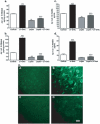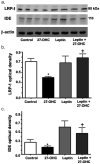Leptin reduces the accumulation of Abeta and phosphorylated tau induced by 27-hydroxycholesterol in rabbit organotypic slices
- PMID: 20157255
- PMCID: PMC2924284
- DOI: 10.3233/JAD-2010-1298
Leptin reduces the accumulation of Abeta and phosphorylated tau induced by 27-hydroxycholesterol in rabbit organotypic slices
Abstract
Accumulation of amyloid-beta (Abeta) peptide and deposition of hyperphosphorylated tau protein are two major pathological hallmarks of Alzheimer's disease (AD). We have shown that cholesterol-enriched diets and its metabolite 27-hydroxycholesterol (27-OHC) increase Abeta and phosphorylated tau levels. However, the mechanisms by which cholesterol and 27-OHC regulate Abeta production and tau phosphorylation remain unclear. Leptin, an adipocytokine involved in cell survival and in learning, has been demonstrated to regulate Abeta production and tau hyperphosphorylation in transgenic mice for AD. However, the involvement of leptin signaling in cholesterol and cholesterol metabolites-induced Abeta accumulation and tau hyperphosphorylation are yet to be examined. In this study, we determined the effect of high cholesterol diet and 27-OHC on leptin expression levels and the extent to which leptin treatment affects 27-OHC-induced AD-like pathology. Our results show that feeding rabbits a 2% cholesterol-enriched diet for 12 weeks reduces the levels of leptin by approximately 80% and incubating organotypic slices from adult rabbit hippocampus with 27-OHC reduced leptin levels by approximately 30%. 27-OHC induces a 1.5-fold increase in Abeta (40) and a 3-fold increase in Abeta (42) and in phosphorylated tau. Treatment with leptin reversed the 27-OHC-induced increase in Abeta and phosphorylated tau by decreasing the levels of BACE-1 and GSK-3beta respectively. Our results suggest that cholesterol-enriched diets and cholesterol metabolites induce AD-like pathology by altering leptin signaling. We propose that leptin administration may prevent the progression of sporadic forms of AD that are related to increased cholesterol and oxidized cholesterol metabolite levels.
Figures






Similar articles
-
Silencing GADD153/CHOP gene expression protects against Alzheimer's disease-like pathology induced by 27-hydroxycholesterol in rabbit hippocampus.PLoS One. 2011;6(10):e26420. doi: 10.1371/journal.pone.0026420. Epub 2011 Oct 14. PLoS One. 2011. Retraction in: PLoS One. 2024 Jul 19;19(7):e0307751. doi: 10.1371/journal.pone.0307751. PMID: 22046282 Free PMC article. Retracted.
-
Endoplasmic reticulum stress-induced CHOP activation mediates the down-regulation of leptin in human neuroblastoma SH-SY5Y cells treated with the oxysterol 27-hydroxycholesterol.Cell Signal. 2012 Feb;24(2):484-492. doi: 10.1016/j.cellsig.2011.09.029. Epub 2011 Oct 1. Cell Signal. 2012. PMID: 21983012 Free PMC article.
-
FLZ alleviates the memory deficits in transgenic mouse model of Alzheimer's disease via decreasing beta-amyloid production and tau hyperphosphorylation.PLoS One. 2013 Nov 4;8(11):e78033. doi: 10.1371/journal.pone.0078033. eCollection 2013. PLoS One. 2013. PMID: 24223757 Free PMC article.
-
Potential mechanisms linking cholesterol to Alzheimer's disease-like pathology in rabbit brain, hippocampal organotypic slices, and skeletal muscle.J Alzheimers Dis. 2008 Dec;15(4):673-84. doi: 10.3233/jad-2008-15412. J Alzheimers Dis. 2008. Retraction in: J Alzheimers Dis. 2024;98(1):341. doi: 10.3233/JAD-239016. PMID: 19096164 Free PMC article. Retracted. Review.
-
Alzheimer's disease.Subcell Biochem. 2012;65:329-52. doi: 10.1007/978-94-007-5416-4_14. Subcell Biochem. 2012. PMID: 23225010 Review.
Cited by
-
27-hydroxycholesterol promotes Aβ accumulation via altering Aβ metabolism in mild cognitive impairment patients and APP/PS1 mice.Brain Pathol. 2019 Jul;29(4):558-573. doi: 10.1111/bpa.12698. Epub 2019 Jan 22. Brain Pathol. 2019. PMID: 30582229 Free PMC article.
-
Hyperleucinemia causes hippocampal retromer deficiency linking diabetes to Alzheimer's disease.Neurobiol Dis. 2014 May;65:188-92. doi: 10.1016/j.nbd.2013.12.017. Epub 2014 Jan 14. Neurobiol Dis. 2014. PMID: 24440570 Free PMC article.
-
Does the oxysterol 27-hydroxycholesterol underlie Alzheimer's disease-Parkinson's disease overlap?Exp Gerontol. 2015 Aug;68:13-8. doi: 10.1016/j.exger.2014.09.013. Epub 2014 Sep 28. Exp Gerontol. 2015. PMID: 25261765 Free PMC article. Review.
-
Oligomeric forms of insulin amyloid aggregation disrupt outgrowth and complexity of neuron-like PC12 cells.PLoS One. 2012;7(7):e41344. doi: 10.1371/journal.pone.0041344. Epub 2012 Jul 27. PLoS One. 2012. PMID: 22848469 Free PMC article.
-
Leptin signaling and Alzheimer's disease.Am J Neurodegener Dis. 2012;1(3):245-65. Epub 2012 Nov 18. Am J Neurodegener Dis. 2012. PMID: 23383396 Free PMC article.
References
-
- Jick H, Zornberg GL, Jick SS, Seshadri S, Drachman DA. Statins and the risk of dementia. Lancet. 2000;356:1627–1631. - PubMed
-
- Wolozin B. Cholesterol and the biology of Alzheimer’s disease. Neuron. 2004;41:7–10. - PubMed
-
- Refolo LM, Pappolla MA, Malester B, LaFrancois J, Bryant-Thomas T, Wang R, Tint GS, Sambamurti K, Duff K. Hypercholesterolemia upon differentiation associated increases in tau and cyclin-dependent kinase accelerates the Alzheimer’s amyloid pathology in a transgenic mouse model. Neurobiol Dis. 2000;7:321–331. - PubMed
-
- Fassbender K, Simons M, Bergmann C, Stroick M, Lutjohann D, Keller P, Runz H, Kuhl S, Bertsch T, von Bergmann K, Hennerici M, Beyreuther K, Hartmann T. Simvastatin strongly reduces levels of Alzheimer’s disease beta-amyloid-peptides Aβ42 and Aβ40 in vitro and in vivo. Proc Natl Acad Sci U S A. 2001;98:5856–5861. - PMC - PubMed
Publication types
MeSH terms
Substances
Grants and funding
LinkOut - more resources
Full Text Sources
Miscellaneous

